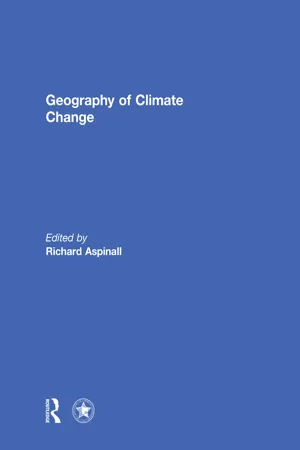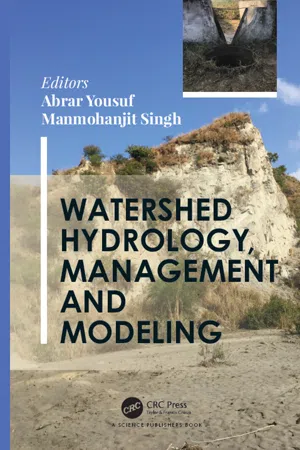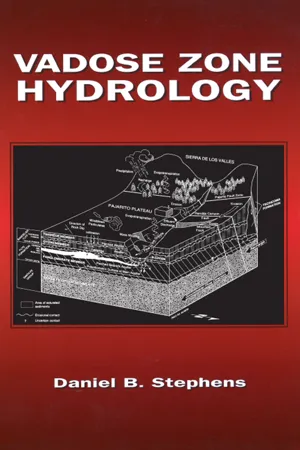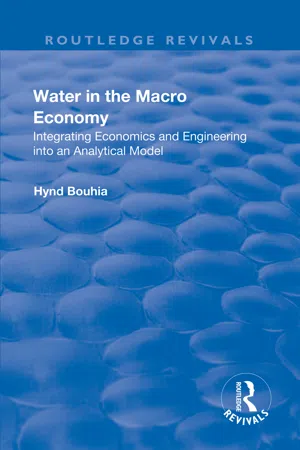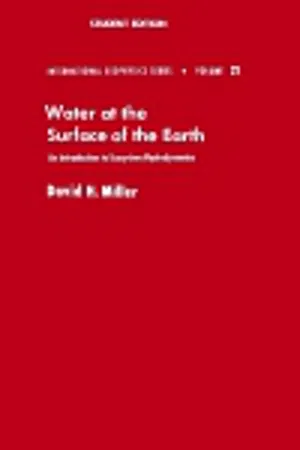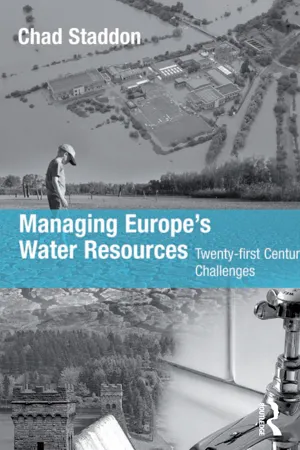Geography
Water Budgets
Water budgets refer to the balance of water inputs, outputs, and storage within a specific area over a defined period. They account for precipitation, evaporation, runoff, and groundwater recharge to assess the availability and distribution of water resources. By analyzing these components, water budgets help in understanding the hydrological cycle and managing water usage and conservation.
Written by Perlego with AI-assistance
Related key terms
Related key terms
1 of 4
Related key terms
1 of 3
6 Key excerpts on "Water Budgets"
- eBook - ePub
- Richard Aspinall(Author)
- 2013(Publication Date)
- Routledge(Publisher)
Although average global temperatures are on the rise, regional patterns are more complex and variable. As such, attention is shifting from questions of change detection and attribution to investigating more localized patterns and impacts of short- and long-term change (Kintisch 2008). It is at these scales that many of the systemic consequences of climate change will present themselves, often mediated by the availability of water (Bates et al. 2008). Hydrological systems are likely to be altered not only by shifting precipitation patterns in the form of seasonal changes in the timing, intensity, magnitude, and phase state of precipitation but also by changes in surficial energy receipt, evaporation, and transpiration (IPCC 2007). Likewise, terrestrial ecosystems are affected by changes in moisture availability and ensuing disturbance, such as wildfire (Westerling et al. 2006; vanMantgem et al. 2009). Beyond direct health consequences (Patz et al. 2005), societal impacts will stem from modified environmental conditions that affect crop production (Battisti and Naylor 2009) and freshwater resources (Vörösmarty et al. 2000).Climatic water budget analysis has long been used to identify spatial and temporal patterns in water utilization, flows, and storage at the Earth’s surface (Mather 1991; Muller and Grymes 2005). This modeling approach integrates climatic controls with their resultant hydrological conditions (e.g., streamflow, soil moisture content) and therefore provides a useful means of testing how changes in energy, temperature, and precipitation alter the components of the hydrologic system. Since its inception, the water budget has been extensively applied to quantify global and regional hydroclimatic patterns (e.g., Willmott, Rowe, and Mintz 1985; Hay and McCabe 2002; Legates and McCabe 2005; Grundstein 2008) and their biogeographic (e.g., Stephenson 1998), fluvial (e.g., Flerchinger and Cooley 2000), and water resource (e.g., Frei et al. 2002) influences. Researchers have also demonstrated the usefulness of this approach in identifying regional consequences of past and anticipated climatic change (e.g., Mather and Feddema 1986; McCabe et al. 1990; Grundstein 2009).This article seeks to further the goal of clarifying patterns of regional-scale climatic variability through quantification and visualization of change in water budget conditions within the contiguous United States. We use a combination of historical observational climate data and global climate model projections to identify spatial and temporal trends in twentieth-century water budget variables, which are then compared to conditions resulting from anticipated changes in temperature and precipitation by the end of the twenty-first century. Through this analysis we assess the extent to which projected water budget values are within the range of variability seen during the twentieth century and how this varies geographically. - eBook - ePub
- Abrar Yousuf, Manmohanjit Singh, Abrar Yousuf, Manmohanjit Singh(Authors)
- 2019(Publication Date)
- CRC Press(Publisher)
Eq. (1) indicate outflow of water from the watershed and positive terms indicate inflow of water into the watershed. The term on the right hand side can either be positive or negative, depending upon increase or decrease in the net total moisture storage in the soil profile and groundwater reservoir of the watershed during the periods of interest. Stream flow will occur only if inputs of water to the watershed exceed all of the other outputs or uses of water in the watershed. If other water demands or outputs exceed total inputs, stream flow will not be there. Runoff water which is going as stream flow is required to be managed to a minimum within the watershed through conservation treatments to maintain watershed hydrologic health.For application of hydrologic budget equation on a watershed, the variables of the equation are required to be determined. Precipitation is measured by rain or snow gauges; runoff by various devices such as weirs, flumes, current meters and depth gauges; infiltration by infiltrometers, or estimated through rainfall simulators or precipitation–runoff data; evapotranspiration is estimated by using evaporation pans, energy budgets, heat and mass transfer methods or empirical relationship based on climatic factors. Soil moisture can be measured by using neutron probes, sensors or gravimetric methods. Groundwater storage and flow is exceedingly difficult to estimate since knowledge of the geology of the watershed is essential. The evaluation of the storage terms depends on the time period over which the water balance is computed. On an annual basis, the change in water content of the root zone is likely to be small in relation to the total water balance and can be neglected. Over a shorter period, the change in the soil water storage can be significant and must be considered. When applied carefully, the hydrologic budget equation can yield good estimates of the magnitudes of required hydrologic variable.Considering that hydrology is not an exact science, reasonable well-founded assumptions are required to solve practical problems in the field. The hydrologic budget equation when applied to large watersheds, the assumption that groundwater inflow and outflow across the boundary of the watershed is zero is quite valid as generally groundwater divide follows surface divide. Also when considering a large time span such as an year, the term Δ(SS + SGW - eBook - ePub
- Daniel B. Stephens(Author)
- 2018(Publication Date)
- CRC Press(Publisher)
CHAPTER 2Soil-Water BudgetIn the previous chapter, we discussed the general nature of the vadose zone, as well as fluid flow and storage characteristics. For many problems, it is important to develop an accounting system to track additions, depletions, and changes of water storage in what is referred to as a water balance or water budget. A water budget is an equation of water mass conservation for a particular volume or region. In hydrology, one can derive a water budget for a surface water body, watershed, aquifer system, or vadose zone. These regions are clearly linked together, inasmuch as the output from one becomes the input to another.This chapter presents an overview of the major components of a vadose zone water budget or what soil scientists refer to as a soil-water budget. This overview sets the stage for more detailed discussions in the subsequent two chapters of some of these soil-water budget components that are most important in hydrogeologic investigations.The general equation for the soil-water budget is derived by considering the mechanisms by which water can enter, exit, or be stored in a predefined region of the vadose zone. For many problems, the inflow across the upper boundary of the vadose zone is infiltration, while outflow from the upper boundary is evaporation and transpiration, and outflow from the lower boundary is groundwater recharge. Net inflow (inflow minus outflow) must equal the change in soil water stored in the vadose zone. In the soil-water budget equation, for a discrete time interval, we add flows due to processes that contribute water to the vadose zone, subtract discharges and water losses, and equate this to changes in the water stored in the soil volume:I − E − T − R = Δ S(1)where I is infiltration, E is evaporation, T is transpiration, R is deep percolation or recharge (all four variables in units of L3 T−1 ), and AS represents the change in water storage over the time interval Δt. The horizontal area in Equation 1 is problem dependent, but usually one can deal with a unit cross-sectional area (in plan view). One can divide both sides of the equation by the area, and express the water-budget components on the left-hand side as fluxes, rates, or specific discharges having units of LT−1 - eBook - ePub
Water in the Macro Economy
Integrating Economics and Engineering into an Analytical Model
- Hynd Bouhia(Author)
- 2018(Publication Date)
- Routledge(Publisher)
The relationship among them is: P = I + A E T + O F + d S M + d G W S + G W R FIGURE 3-2 Components of the Hydrological Cycle Each term of the water balance equation can be evaluated directly in the field. The water balance will be considered at a regional and a national level, to assess the human impact on the water cycle. For the purpose of this book, we will assume that the effect of change in soil moisture is negligible, and it will not be taken into consideration. The Water Budget The water budget is an attempt to capture the effect of human economic water uses on the water balance. It encompasses both the different steps of the water cycle and the economic production chains requiring water as an input. A water budget is computed for a fixed amount of time; we will use one year, to match the cycles of the economic account. As shown in Figure 3-3, the water budget brings out the modifications of a region s hydrological cycle by the changes made by humans in the path of rainwater and snow-melt, as well as groundwater. These are of concern to water planners and economists. The same water budget is shown in Figure 3-4, illustrating the flows of water from sources to water users and then back to sources. The economic sectors use this water, after it has been handled in some cases by water utilities. Water is consumed by agriculture, both rainfed and irrigated, by manufacturing and industry, by services, and by domestic households. A quite small percentage of the water used is embedded in economic products and leaves the hydrological cycle, which has to be taken into consideration to ensure a closed balance. After use, the rest of the economically-used water follows paths similar to the natural case, either evaporation, infiltration to the ground, or return to a surface stream - eBook - ePub
Water at the Surface of Earth
An Introduction to Ecosystem Hydrodynamics
- David M. Miller(Author)
- 1982(Publication Date)
- Academic Press(Publisher)
The budget idea is obvious for the groundwater reservoir. We can visualize the inflow by deep percolation during rainy seasons of the year, and have all seen outflows in springs and pumped wells. Visualizing also the closed nature of the system, with other modes of entry and exit of water being limited or absent, it is easy to think in budgeting terms. This is particularly relevant when we are considering cyclic rather than inherited groundwater, to use Nace’s distinction. * Indeed the budget is the usual concept applied when man starts to develop or manage a body of groundwater, although difficulties are found in procuring accurate quantities for the inflows and outflows. Some bodies of groundwater also are difficult to delimit. Most groundwater bodies, being constantly in a state of changing equilibrium as inflows and outflows fluctuate, present a complex problem in evaluating how they respond to some change in conditions. Nevertheless, a simplified restatement of the budget is useful. Deep percolation of water, when in excess in the soil, or from wetted stream channels or sites of artificial recharge, usually enters the groundwater body only during certain seasons of the year. Day-to-day changes in its rate are in general unknown. It usually carries freight in the form of solutes dissolved from the soil, salts or fertilizers, or urban wastes. The consequent characteristics of the body of cyclic groundwater fed by percolate are thus its chemical or biological quality, its changing volume, and its temperature. These properties can be monitored more easily than the rates of inflow, and from these records we can deduce the health of the groundwater body. One interest in the state of shallow bodies of groundwater lies in the level of the water table, whether it is too close to cultivated land surfaces or whether it is at the right level for wetland plants and habitat - eBook - ePub
Managing Europe's Water Resources
Twenty-first Century Challenges
- Chad Staddon(Author)
- 2016(Publication Date)
- Routledge(Publisher)
Chapter 1 this idea was introduced through the observation that many nations around the world were increasingly finding themselves in positions of water “scarcity” or “shortage” as their needs outstripped their sources. And above it was implicit, I think, that there should be some sort of balance between the amount of water taken by a given user, or collection of users, and the available resources. Indeed, the situation presented in the last section becomes much more complex if we introduce more “real world” recognitions that there will be a wide variety of users, and that their needs, qualitative as well as quantitative, may be to some degree incompatible (e.g. waters that cannot be used for drinking water supply might be acceptable for irrigation or industrial uses – so-called “conditionally clean” water). Moreover, if we attempt to incorporate flood control, aesthetic, leisure and ecological “uses”, and other sorts of supply such as more effective water recycling (or reduction of consumptive activity), the situation can become yet more complex. In practice water managers are faced with the ongoing challenge of optimising the use of limited water resources among competing uses and users. One tool for looking at issues of “balance” and how to achieve it is the “water balance statement”, in particular as developed by Stephen Merritt and his colleagues in the Water Research Group at SOAS in London (Merritt, 1999, but see also Penkova and Shiklomanov, 1998). In this section we briefly present the logic of the water balance statement as a tool for water management at the level of regions or catchments (which will often be the same thing).The water balance statement will generally relate to catchments (particularly with the advent of integrated water resource management, see page 137 ). The basic methodology involves compiling a spreadsheet with four columns: the first two are the categories of supply and the quantity supplied per unit period of time ; the second two are the categories of use and the quantity used per unit period of time . For simplicity, in Table 5.1 and 5.2 there is only one user, a small town of 2,000 people, and only two supply sources: ground water and of surface water . From these are deducted the leakages and evaporation in the supply system, that is, between the points of abstraction and the supply/use boundary.The calculation of flows in the regional water balance statement requires a form of “double-entry water accounting”. The statement is treated as a single ledger containing all the appropriate entries either as supply items on the left-hand side or as use items on the right-hand side. For any flow of water to be recorded in the statement, it must qualify as some hydrosocial category of input to the regional system. In the water accounts ledger, with comprehensive and accurate records, the statement should always balance . In Tables 5.1 and 5.2 I present a greatly simplified example, based loosely on the hydrograph for The River Kennet presented as Figure 5.1 above. In Table 5.1
Index pages curate the most relevant extracts from our library of academic textbooks. They’ve been created using an in-house natural language model (NLM), each adding context and meaning to key research topics.
Explore more topic indexes
Explore more topic indexes
1 of 6
Explore more topic indexes
1 of 4
